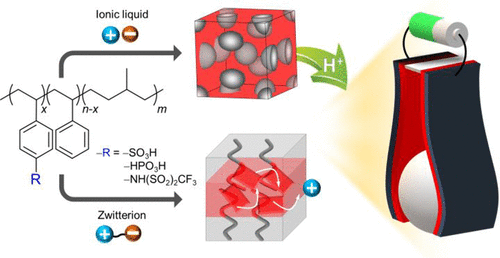当前位置:
X-MOL 学术
›
Acc. Chem. Res.
›
论文详情
Our official English website, www.x-mol.net, welcomes your feedback! (Note: you will need to create a separate account there.)
Charged Block Copolymers: From Fundamentals to Electromechanical Applications
Accounts of Chemical Research ( IF 18.3 ) Pub Date : 2021-09-24 , DOI: 10.1021/acs.accounts.1c00423 Jaemin Min 1 , Dipankar Barpuzary 1 , Hyeonseong Ham 2 , Gyeong-Chan Kang 1 , Moon Jeong Park 1, 2
Accounts of Chemical Research ( IF 18.3 ) Pub Date : 2021-09-24 , DOI: 10.1021/acs.accounts.1c00423 Jaemin Min 1 , Dipankar Barpuzary 1 , Hyeonseong Ham 2 , Gyeong-Chan Kang 1 , Moon Jeong Park 1, 2
Affiliation

|
Charged block copolymers are promising materials for next-generation battery technologies and soft electronics. Although once it was only possible to prepare randomly organized structures, nowadays, well-ordered charged block copolymers can be prepared. In addition, theoretical and experimental analyses of the thermodynamic properties of charged polymers have provided insights into how to control nanostructures via electrostatic interactions and improve the ionic conductivity without compromising mechanical strength, which is crucial for practical applications. In this Account, we discuss methods to control the self-assembly and ion diffusion behavior of charged block copolymers by varying the type of tethered ionic moieties, local concentration of embedded ions with controlled electrostatic interactions, and nanoscale morphology. We discuss with particular emphasis on the structure–transport relationship of charged block copolymers using various ionic additives to control the phase behavior electrostatically as well as the ion transport properties. Through this, we establish the role of interconnected ionic channels in promoting ion-conduction and the importance of developing three-dimensional interconnected morphologies such as gyroid, orthorhombic Fddd (O70) networks, body-centered cubic (bcc), face-centered cubic (fcc), and A15 structures with well-defined interfaces in creating less tortuous ion-conduction pathways. Our prolonged surge and synthetic advances are pushing the frontiers of charged block copolymers to have virtually homogeneous ionic domains with suppressed ion agglomeration via the nanoconfinement of closely bound ionic moieties, resulting in efficient ion conduction and high mechanical strength.
中文翻译:

带电嵌段共聚物:从基础到机电应用
带电嵌段共聚物是下一代电池技术和软电子产品的有前途的材料。虽然曾经只能制备随机组织的结构,但现在,可以制备有序的带电嵌段共聚物。此外,带电聚合物的热力学性质的理论和实验分析为如何通过静电相互作用控制纳米结构和提高离子电导率而不影响机械强度提供了见解,这对于实际应用至关重要。在这个帐户中,我们讨论了通过改变束缚离子部分的类型、具有受控静电相互作用的嵌入离子的局部浓度和纳米级形态来控制带电嵌段共聚物的自组装和离子扩散行为的方法。我们特别强调了使用各种离子添加剂来控制静电相行为以及离子传输特性的带电嵌段共聚物的结构-传输关系。通过这一点,我们确立了互连离子通道在促进离子传导中的作用以及发展 3D 互连形态如 gyroid、orthorhombic 的重要性。Fddd (O 70 ) 网络、体心立方 (bcc)、面心立方 (fcc) 和 A15 结构,具有明确定义的界面,可创建不那么曲折的离子传导路径。我们长期的激增和合成进展正在推动带电嵌段共聚物的前沿,通过紧密结合的离子部分的纳米限制,具有几乎均匀的离子域和抑制离子团聚,从而实现有效的离子传导和高机械强度。
更新日期:2021-11-03
中文翻译:

带电嵌段共聚物:从基础到机电应用
带电嵌段共聚物是下一代电池技术和软电子产品的有前途的材料。虽然曾经只能制备随机组织的结构,但现在,可以制备有序的带电嵌段共聚物。此外,带电聚合物的热力学性质的理论和实验分析为如何通过静电相互作用控制纳米结构和提高离子电导率而不影响机械强度提供了见解,这对于实际应用至关重要。在这个帐户中,我们讨论了通过改变束缚离子部分的类型、具有受控静电相互作用的嵌入离子的局部浓度和纳米级形态来控制带电嵌段共聚物的自组装和离子扩散行为的方法。我们特别强调了使用各种离子添加剂来控制静电相行为以及离子传输特性的带电嵌段共聚物的结构-传输关系。通过这一点,我们确立了互连离子通道在促进离子传导中的作用以及发展 3D 互连形态如 gyroid、orthorhombic 的重要性。Fddd (O 70 ) 网络、体心立方 (bcc)、面心立方 (fcc) 和 A15 结构,具有明确定义的界面,可创建不那么曲折的离子传导路径。我们长期的激增和合成进展正在推动带电嵌段共聚物的前沿,通过紧密结合的离子部分的纳米限制,具有几乎均匀的离子域和抑制离子团聚,从而实现有效的离子传导和高机械强度。



























 京公网安备 11010802027423号
京公网安备 11010802027423号